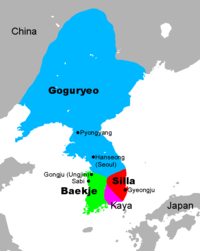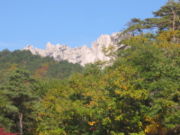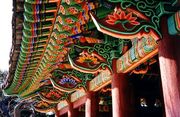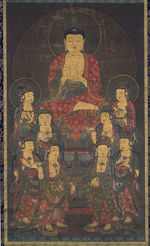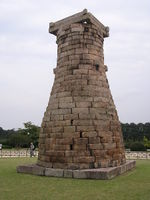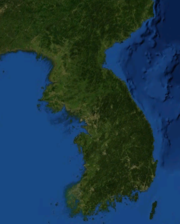Korea
2007 Schools Wikipedia Selection. Related subjects: Asian Countries; Countries
| Korea | |
|---|---|
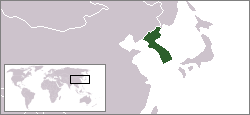 |
|
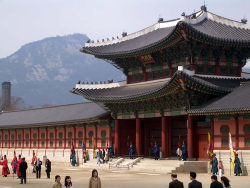 |
|
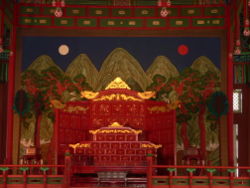 |
|
Korea ( Korean: 한국 or 조선, see below) is a geographic area, civilization, and former state situated on the Korean Peninsula in East Asia. The peninsula is currently divided into North Korea and South Korea, and borders China to the northwest and Russia to the northeast, with Japan situated to the southeast across the Korea Strait.
Korea began with the founding of Gojoseon in 2333 BC, according to the Dangun legend. Limited linguistic evidence suggests possible Altaic- Tungusic origins of these people, whose northern Mongolian Steppe culture absorbed immigrants and invaders from northern China. The adoption of the Chinese writing system (" hanja" in Korean) in the 2nd century BCE, and Buddhism in the 4th century CE, had profound effects on its society. Koreans later passed on these, as well as their own advances, to Japan.
After the unification of the Three Kingdoms of Korea by Silla in 676, Korea was ruled by a single government and maintained political and cultural independence, despite the Mongol invasions of the Goryeo Dynasty in the 13th century and Japanese invasions of the Joseon Dynasty in the 16th century. In 1377, Korea produced the Jikji, the world's oldest printed document using movable metal type. In the 15th century, the turtle ships, possibly the world's first ironclad warships, were deployed, and during the reign of King Sejong the Great, the Korean alphabet hangul was created.
During the latter part of the Joseon Dynasty, Korea's isolationist policy earned it the Western nickname the " Hermit Kingdom". By the late 19th century, the country became the object of colonial designs by the imperial aggressors of Japan and Europe. In 1910, Korea was forcibly annexed by Japan and remained occupied until the end of World War II in 1945.
In 1945, Soviet Union and United States troops occupied the northern and southern halves of the country, respectively. The two Cold War enemies helped establish governments sympathetic to their own ideologies, leading to Korea's current division into two political entities: North Korea and South Korea.
Names of Korea
The name "Korea" derives from the Goryeo period of Korean history, which in turn referred to the ancient kingdom of Goguryeo. It is now commonly used in English contexts by both North and South Korea.
In the Korean language, Korea as a whole is referred to as Chosŏn ( Korean chosŏn'gŭl: 조선; hanja: 朝鮮; McCune-Reischauer: Chosǒn; revised: Joseon ) by North Korea and Han-guk ( hangul: 한국
- hanja
- 韓國
- revised
- Hanguk
- McCune-Reischauer
- Han'guk) by South Korea.
History
There is archaeological evidence that people were living on the Korean Peninsula around 700,000 years ago, during the Lower Paleolithic. The earliest known Korean pottery dates to around 8000 BC, and the Neolithic period begins around 6000 BC. According to the Dangun legend, Gojoseon was founded in 2333 BC. Archaeological and contemporary written records indicate it developed from a federation of walled cities into a centralized kingdom sometime between the 7th and 4th centuries BC. The original capital may have been at the Manchuria-Korea border, but was later moved to today's Pyongyang, North Korea. In 108 BC, the Chinese Han Dynasty defeated Wiman Joseon and installed four commanderies in the area of Liaoning. By 75 BC, three of those commanderies had fallen, but one commandery remained under Chinese control until 313 AD.
The Three Kingdoms of Korea ( Goguryeo, Silla, and Baekje) dominated the peninsula and parts of Manchuria during the early Common Era. They competed with each other both economically and militarily. Goguryeo united Buyeo, Okjeo, Dongye and other states in the former Gojoseon territory, in addition to destroying the last Chinese commandery. Goguryeo was the most dominant power, but was at constant war with the Sui and Tang dynasties of China. Founded around today's Seoul, the southwestern kingdom Baekje extended beyond Pyongyang during the peak of its powers in the 4th century. Although later records claim Silla, in the southeast, was the oldest of the three kingdoms, it is now believed to have been the last kingdom to develop.
In the 5th, 6th, and 7th centuries, Silla's power gradually extended across Korea. Silla first annexed the adjacent Gaya confederacy. By the 660s, Silla formed an alliance with the Tang Dynasty of China to conquer Baekje and later Goguryeo. After repelling Chinese forces, Silla established the first unified state to cover most of Korea; this period is often called Unified Silla. After the fall of Goguryeo, former Goguryeo general Dae Joyeong led a group of Koreans to the Jilin area in Manchuria and founded Balhae (698 AD - 926 AD) as the successor to Goguryeo. At its height, Balhae's territory extended from northern Manchuria down to the northern provinces of modern-day Korea. Balhae was destroyed by the Khitans in 926, and many remaining people from Balhae entered into Goryeo.
Unified Silla fell apart in the late 9th century, giving way to the tumultuous Later Three Kingdoms period (892-936), which ended with the establishment of the Goryeo Dynasty. During the Goryeo period, laws were codified, a civil service system was introduced, and Buddhism flourished. Conflict increased between civil and military officials as the latter were degraded and poorly paid. In 1238, the Mongolian Empire invaded. After nearly thirty years of war, the two sides signed a treaty that favored the Mongols. In the 1340s, as the Mongol Empire declined rapidly, and Korea was able to pursue reform without interference.
In 1392, the general Yi Seong-gye established the Joseon Dynasty (1392-1910) with a largely bloodless coup. The Joseon Dynasty is believed to have been the longest-lived actively ruling dynasty in East Asia. King Sejong the Great (1418-1450) promulgated Hangul, the Korean alphabet, and this period saw various other cultural and technological advances. Between 1592-1598, Japan invaded Korea, but was eventually repelled with the aid of China. In the 1620s and 1630s Joseon suffered invasions by the Manchu Qing Dynasty, who eventually also conquered the Chinese Ming Dynasty.
Beginning in the 1870s, Japan began to force Korea to move out of China's sphere of influence into its own. In 1895, Empress Myeongseong of Korea was assassinated by the Japanese under Miura Goro's directive (Kim et al. 1976). In 1910, Japan forced Korea to sign the Japan-Korea Annexation Treaty, although executed by Korean ministers and advisors rather than the Korean head of state, the emperor.
Korean resistance to the brutal Japanese occupation was manifested in the massive nonviolent March 1st Movement of 1919, where 7,000 demonstrators were killed by Japanese police and military. Thereafter the Korean independence movement was largely active in neighboring Manchuria and Siberia.
Over five million Koreans were conscripted for labor beginning in 1939 and tens of thousands of men were conscripted into Japan's military. Approximately 200,000 girls and women, mostly from Korea and China, were pressed into work as sex slaves, euphemistically called " comfort women".
The Korean language was banned in official documents and Koreans were obligated to adopt Japanese names. Traditional Korean culture suffered heavy losses, as numerous Korean cultural artifacts were destroyed or taken to Japan. To this day, valuable Korean artifacts can often be found in Japanese museums or among private collectors. One investigation by the South Korea government identified 75,311 cultural assets that were taken from Korea, 34,369 of which are in Japan, and 17,803 of which are in the United States.
With the defeat of Japan in 1945, the United Nations developed plans for a trusteeship administration, the Soviet Union administering the peninsula north of the 38th parallel and the United States administering the south. The politics of the Cold War resulted in the 1948 establishment of two separate governments, North Korea and South Korea. The Korean War began in June 1950 and lasted until 1953. Millions of civilians died and the United States waged a bombing campaign over North Korea that effectively destroyed most cities. The war ended in a ceasefire agreement at approximately the same boundary. Both Korean states proclaim eventual reunification as a goal.
Geography
Korea is located on the Korean Peninsula in North-East Asia. It is bound by two countries and three seas. To the northwest, the Yalu River separates Korea from China and to the northeast, the Tumen River separates Korea from Russia. The Yellow Sea is to the west, the East China Sea is to the south, and the Sea of Japan ( East Sea) is to the east of Korea. Notable islands include Jeju-do, Ulleung-do, and Dokdo.
The southern part and western part of the Korean mainland have well developed plains, while the eastern and northern parts are mountainous. The highest mountain in Korea is Mt. Baekdu (2744 m, Chinese say Changbaishan). The border with China runs through the mountain. The southern extension of Mt. Baekdu is a highland called Gaema Gowon. This highland was mainly raised during the Cenozoic orogeny and partly covered by volcanic matter. To the south of Gaema Gowon, successive high mountains are located along the eastern coast of the peninsula. This series of mountains is named Baekdudaegan. Some significant mountains include Sobaeksan (2,184 m), Baeksan (1,724 m), Geumgangsan (1,638 m), Seoraksan (1,708 m), Taebaeksan (1,567 m), and Jirisan (1,915 m). There are several lower, secondary mountain series whose direction is almost perpendicular to that of Baekdudaegan. They are developed along the tectonic line of Mesozoic orogeny and their directions are NW, NWW.
Unlike most older mountains on the mainland, many important islands in Korea were formed by volcanic activity in the Cenozoic orogeny. Jeju-do, situated off the southern coast, is a large volcanic island whose main mountain Mt. Halla (1950 m) is the highest in South Korea. Ulleung-do is a volcanic island in the Sea of Japan, who's composition is more feslic than Jeju-do. The volcanic islands tend to be younger as one moves westward.
Because the mountainous region is mostly on the eastern part of the peninsula, the main rivers tend to flow westwards. Two exceptions are the southward-flowing Nakdong River and the Seomjin River. Important rivers running westward include the Yalu, the Cheongcheon River, the Daedong River, the Han River, the Geum River, and the Yeongsan River. These rivers have vast flood plains and they provide an ideal environment for wet-rice cultivation.
The southern and southwestern coastlines of Korea form a well-developed Lias coastline, known as Dadohae in Korean. Its complicated coastline provides mild seas, and the resulting calm environment allows for safe navigation, fishing, and seaweed farming. In addition to the complex coastline, the western coast of the Korean peninsula has an extremely high tidal amplitude (at Incheon, around the middle of the western coast. It can get as high as 9 m). Vast tidal flats have been developing on the south and west coastlines.
Demographics
Korea is populated by a highly homogeneous ethnic group, the Koreans, who speak a distinct language called Korean.
A minority of ethnic Chinese (about 20,000) live in South Korea and small communities of ethnic Chinese and Japanese live in North Korea.
The combined population of the Koreas is about 72 million.
Age reckoning
One peculiarity of Korean culture is that individuals are regarded as one year old when they are born, and their age increments on New Year's Day rather than on the anniversary of their birthday. Accordingly, a Korean person's stated age will be one or two years more than their age expressed in the Western tradition.
Language
Korean is the official language of both North and South Korea, and is widely spoken in Korean communities abroad. The language is also one of the two official languages (the other is Standard Mandarin) in neighbouring Yanbian, China. Worldwide, there are around 80 million Korean speakers, including large groups in the former Soviet Union, China, Australia, the United States, Canada, Brazil, Japan, and more recently, the Philippines.
The genealogical classification of Korean is debated. Some linguists place it in the Altaic language family; others consider it to be a language isolate. Korean is agglutinative in its morphology and SOV in its syntax. Like Japanese and Vietnamese, Korean has borrowed much vocabulary from Chinese or created vocabulary on Chinese models.
Modern Korean is written almost exclusively in the Hangul script, which was invented in the 15th century. While Hangul may look like logographic Chinese writing to some, it is actually a phonemic alphabet organized into syllabic blocks. Each block consists of at least two of the 24 Hangul letters ( jamo): at least one each of the 14 consonants and 10 vowels. Historically, the alphabet had several additional letters (see obsolete jamo). For a phonological description of the letters, see Korean phonology. Hanja (Chinese characters) and Roman characters are sometimes included within hangul texts, particularly in South Korea.
Culture and Arts
In ancient Chinese texts, Korea is referred to as "Rivers and Mountains Embroidered in Silk" (錦繡江山) and "Eastern Nation of Decorum" (東方禮儀之國). During the 7th and 8th centuries, land and sea trading networks connected Korea to Arabia. As early as 845, Arab traders mentioned Korea saying, ""Beyond China is a land where gold abounds and which is named Silla. The Muslims who have gone there have been charmed by the country and tend to settle there and abandon all idea of leaving."
Korean festivities often showcase vibrant colors, which have been attributed to Mongolian influences: bright red, yellow, and green often mark traditional Korean motifs. These bright colors are sometimes seen in the traditional dress known as hanbok.
Literature
Korean literature is traditionally divided into two categories. The literature written until the end of the Joseon Dynasty is called "Classical".
Classical Korean literature has its roots in traditional folk beliefs and folk tales of the Korean peninsula. Other influences include Confucianism, Buddhism and to some extent Taoism. Traditional Korean literature, written in Chinese characters (hanja), was established at the same time as the Chinese script arrived on the peninsula. Korean scholars were writing poetry in the classical Chinese style as early as the 4th century. Some historians exclude these forms of literature from Korean literature, arguing that they were merely forms of Chinese literature. Others argue, however, that the fact that Chinese characters were used is not reason enough to exclude the literature from the classical Korean canon, particularly since it reflects Korean thought and experience.
Modern literature is often linked with the development of hangul, which helped spread literacy from the dominant classes to the common people, including women. Hangul, however, only reached a dominant position in Korean literature in the second half of the 19th century, resulting in a major growth in Korean literature. Sinsoseol, for instance, are novels written in hangul.
The Korean War led to the development of literature centered around the wounds and chaos of war. Much of the post-war literature in South Korea deals with the daily lives of ordinary people, and their struggles with national pain. The collapse of the traditional Korean value system is another common theme of the time.
Religion and education
Confucian tradition has dominated Korean thought, along with contributions by Buddhism, Taoism, and Korean Shamanism. Since the middle of the 20th century, however, Christianity has competed with Buddhism in South Korea, while religion has been suppressed in North Korea.
According to 2003 statistics compiled by the South Korean government, about 46% of citizens profess to follow no particular religion. Christians account for 27.3% of the population and Buddhists 25.3%.
Koreans valued scholarship and rewarded education and study of Chinese classic texts; Yangban boys were highly educated in Hanja. In Silla, the bone rank system defined a person's social status, and a similar system persisted through the end of the Joseon Dynasty. In addition, the gwageo civil service examination provided paths of upward mobility.
Cuisine
Korean cuisine is probably best known for kimchi, which uses a distinctive fermentation process of preserving vegetables. Chili peppers are also commonly used, earning the cuisine a reputation for being spicy. Fish, generally grilled or stewed, is the primary source of protein. Bulgogi (roasted marinated beef, chicken, or pork), galbi (ribs), and samgyeopsal (pork fatback) are popular meat entrees. Korean meals are usually accompanied by a soup or stew, often made with dwenjang bean paste. Popular dishes are bibimbap (mixed rice), naengmyeon (cold noodles), galbitang (stewed ribs), and dwenjang jjigae (fermentated bean paste stew).
Science and technology
One of the best known artifacts of Korea's history of science and technology is Cheomseongdae, a 9-meter high observatory built in 633. It is considered to be the world's oldest surviving astronomical observatory.
The world's earliest known block printed document is thought to be a Buddhist scripture (a copy of the Jikji) believed printed in Korea in 750-751 CE which, if correct, would make it older than the Diamond Sutra. The world's first metal movable type was developed in Korea in 1232 by Chae Yun-ui during the Goryeo Dynasty, modeled after widespread Chinese clay ( Bi Sheng in 1041) and wooden movable type invented by Koreans from Unified Silla , before Johann Gutenberg developed his metal letterset type (Cumings 1997: 65). Though the block printing was used much earlier, metal movable type marked a significant development in printing allowing the same tools to be used for more diverse printings.
Some Chinese thought Korean porcelains were of the finest quality before and during the Goryeo Dynasty. During the Goryeo period, Korea advanced traditional arts and crafts, such as white celadon glazes, fine silk, paper and Sword making.
The apex of astronomical and calendarial advances made under King Sejong was the Ch'ilchongsan, developed in 1442. This work made it possible for scientists to calculate and accurately predict all the major heavenly phenomena, such as solar eclipses and other stellar movements. Hangul, perhaps the most scientifically designed script in widespread use, is attributed to King Sejong the Great in 1443. An automated water clock, the Jagyeokru which worked by activating motions of wooden figures to indicate time visually was invented in 1434 by Jang Yeong-sil, who later developed a more complicated water-clock with additional astronomical devices, as well as the worlds first Iron Printing Press, water gauge, and the rain gauge also during the Joseon Dynasty Heo Jun, a court physician wrote a number of medical texts, but his most significant achievement is Dongeui Bogam, which is often noted as the defining text of Traditional Korean medicine. The work spread to China and Japan, where it is still regarded as one of the classics of Oriental medicine today.
During the Joseon period, Korean silk was highly regarded by China and Korean pottery made with blue-green celadon were of the highest quality in the world. Also, during this time, the early ironclad warships, the Geobukseon ( Turtle Ship) were invented, as well as other weapons such as the Bikeokjinchonlae and the hwacha.
